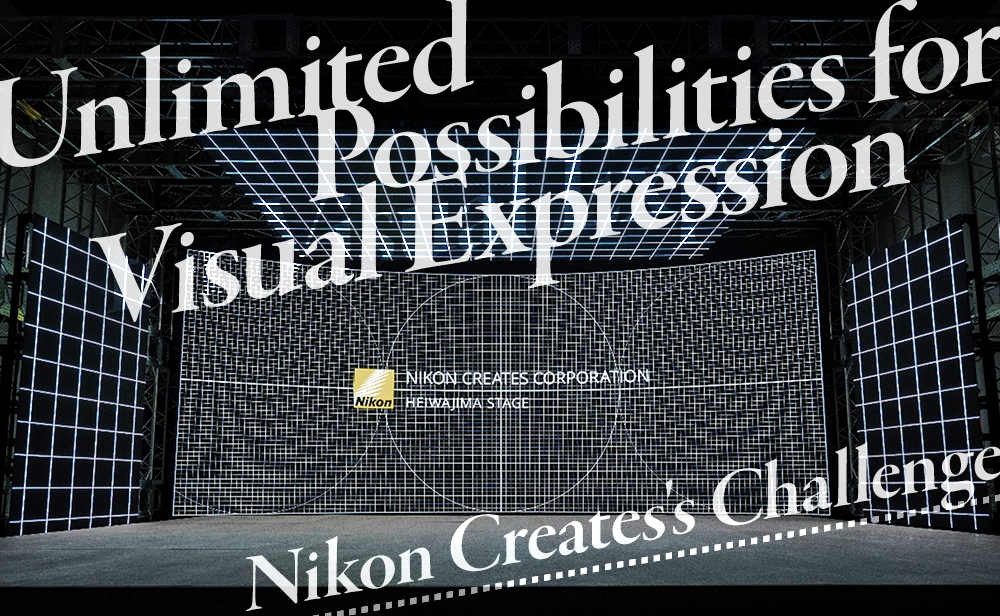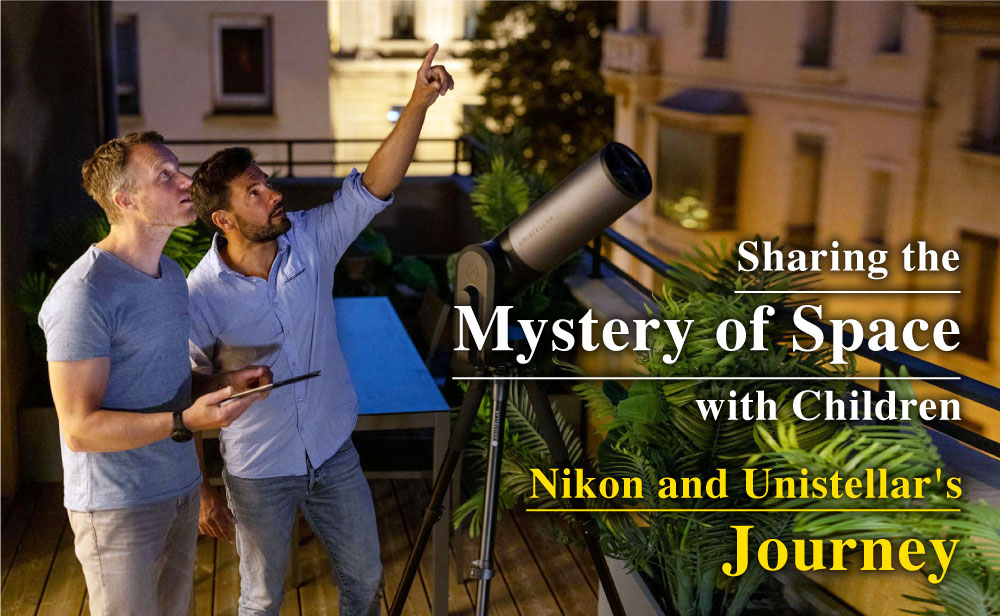
Nikon's Challenge to Push the Potential of Imaging Expression
Times have changed—amid the shift from analog to digital, photos and video are becoming more accessible to all people. With the spread of smartphones and social media and the advancement of technology, "imaging expression" is undergoing great changes.
Nikon has led the development of imaging culture since the dawn of photography and cameras—but how are we approaching the potential of the future of imaging expression? We asked Hiroyuki Ikegami (General Manager of the Imaging Business Unit at Nikon) and Fumiko Kawabata (Department Manager of Marketing Strategy at Nikon's Imaging Business Unit) about the history of imaging expression and its future outlook.
INDEX
Contributing to the global development of imaging culture since the dawn of photography
—Nikon's cameras and lenses have been treasured by fans throughout history. Please tell us how Nikon has contributed to the development of imaging culture over the years.
Ikegami: After Nikon was established in 1917, the company studied optical design and machine processing technologies from German engineers and began designing photographic lenses in full scale, leading way to the development of the NIKKOR brand, later to become synonymous with high-performance lenses. Journalist of U.S. publisher Time's Life magazine David Douglas Duncan, who was stationed in Tokyo at the time, fell in love with NIKKOR lenses and went on to extensively use them for major projects. This helped spread the name of NIKKOR and Nikon across the globe.
In 1959, Nikon released its first single-lens reflex (SLR) camera, the Nikon F. For over 60 years since its release, Nikon's F-Mount cameras and lenses have continued to develop as part of Nikon's high-end SLR cameras and NIKKOR lens series, gathering acclaim from a number of photographers including news media.
Nikon's cameras and lenses are also deeply linked to space. In 1971, the Nikon Photomic FTN was used aboard Apollo 15 in its exploration of the moon. Since then, we have delivered countless products to NASA, including some of our most recent digital SLR cameras. Through supporting space research and observations of the South Pole, we continue our contributions toward scientific advancement. The development of technologies that allow our products to thrive in harsh environments like these, has led to high praise in our current mirrorless cameras like the Z 9, acclaimed as being "highly trustworthy," "accredited by professionals and photographers," and "achieving a comfortable grip."

Kawabata: From a cultural standpoint, we value providing opportunities for photography lovers—both professionals and amateurs alike—to come together, as well as nurturing the development of imaging culture. Since its inception in 1969, the Nikon Photo Contesthas functioned to serve these purposes, as one of the largest international photo and film contest in the world. This contest has long contributed to the development of imaging culture, with evaluations conducted by third-party judges without specifications on the type of equipment used. This year, the Contest marked a record number of entries.

How the spread of social media has changed the landscape of imaging culture and Nikon's challenge
—How is imaging expression changing with the spread of smartphones and social media?
Ikegami: Interest in videos is on the rise with the spread of social media—namely YouTube, TikTok, and Instagram. Especially among younger generations, more people are looking for cameras with an interchangeable lens system for higher quality imagery. Cameras with an interchangeable lens system have larger sensors and more lenses to choose from, allowing users to capture more dramatic and impressive videos for their work.
The potential of imaging expression is sure to continue to expand, such as 3D and 4D content and expression within the metaverse.
Kawabata: The rise of videos is not limited to individual users—there has also been a rapid increase in video content among professional creators, as seen in video streaming platforms like Netflix and Amazon Prime Video. This is particularly the case for those who use their personal equipment to film videos in a one-person operation. A new culture is steadily emerging in the world of videos, and we plan to capitalize on its opportunities.
—What products are popular at the moment?
Ikegami: Full-frame mirrorless cameras like the Z 9 and the Z 6II are popular among creatively passionate users, like younger content creators and those who film in one-person operations. We have been seeing more and more usage at broadcasting agencies as well as for the creation of various content, including music videos.
We are also in the process of recruiting more talent in order to further strengthen our products.

Kawabata: We also provide opportunities to showcase video works around the globe. The previously mentioned Nikon Photo Contesthas added the Super Short Film Category in its Short Film Competition. In Japan, we held a contest specific to vertical-frame videos, called the Vertical Movie Award, and in Europe, we host the Nikon Film Festival. We have also seen increased popularity for our seminar on creating Instagram Reels, which we established to appeal towards generations that are native to social media.
—Have you seen any changes from a marketing standpoint?
Kawabata: On the flip side, we've been seeing younger generations with an interest in film cameras. The process of taking a film photo, as well as the 1980s design, is a fresh experience for them.
The Z fc was inspired by the unique design and operational feel of the FM2, and its appeal lies not only in its specifications, but also in its appeal within the user's lifestyle and hobbies. We have made it easier for users of younger generations to pick up a camera with interchangeable lenses, by making a lifestyle that includes a camera more imaginable.


We are also working to create both online and offline touchpoints. It is important that users can enjoy the experience of our products' performance in real life, not just with images online through channels like social media. As part of these efforts, we have organized offline events for younger influencers and creators across the globe, where they can try our cameras, see its performance, and spread the word of its usability in a casual setting.
—What kind of activities are you implementing to "expand the potential of imaging expression?"
Ikegami: We've expanded services that utilize our products and launched a business that provides contents to customers. For example, our new subsidiary company Nikon Creates Corporation was established in April 2022, launching the operation of a multi-complex facility that enables filming with state-of-the-art video technologies. This facility allows for the filming and production of volumetric videos, a 3D video achieved by 360-degree filming of the subject, and in which the perspective can be altered. It also features the recently popular virtual production, which utilizes a set with an LED screen that depicts visuals and CG as a background.
These are some of the ways we are contributing to the development of a new imaging culture that utilizes innovative technologies.
A unified global team that respects diverse workstyles
—I understand that the Marketing Strategy Department, responsible for the planning and execution of marketing strategies, has many female members with diverse workstyles.
Kawabata: Yes. Our Marketing Strategy Department is relatively younger, with its average age in the thirties, and we also are joined by many women. Our strength is seen in the diverse backgrounds of our members—some with experience in HR or finance, others having worked overseas or in other business units, as well as mid-career recruits. This diversity leads to the birth of new ideas.
Ikegami: The members of our Marketing Strategy department have done great work, despite being a small team. It certainly isn't easy to manage marketing initiatives across the globe. Cultural and language barriers are sometimes encountered in communicating with our overseas offices, with frequent global meetings conducted in English. Our team overcomes these barriers through discussions, creating marketing plans with a global perspective with the goal of creating Nikon fans.
Kawabata: The marketing team at Nikon headquarters conducts work with a global mindset. As a unified global team, we foster a shared understanding of policies and the directions of Nikon headquarters, while also respecting the unique characteristics of each region.
At the Nikon headquarters, we have placed value on working alongside our regional members, sharing the successful examples as well as issues faced within in each region, working together to consider if similar initiatives can be incorporated in other regions and considering where the key factors in issue solving lie.
—Lastly, please share your future vision for the Imaging Business.
Kawabata: Nikon is very lucky in that it is a brand that has been supported by long-time passionate fans. We intend to value our existing fans while also appealing to new ones, especially younger generations, to become a brand beloved among all generations.
From younger generations to our core fans, our marketing aims to be attentive to the needs of each segment. I hope to continue to explore ways in which we can building the brand together.
Ikegami: We hope to continue delivering extraordinary experiences that exceed our customers' expectations. Please continue to look forward to our activities at Nikon!

- *Title and work duties are those at the time of interview
Nikon Imaging Products Business
Imaging Products Business information.
Originally published: April 25, 2023.



